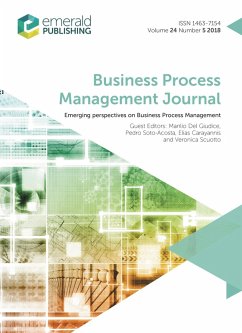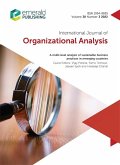Drawing upon the idea that dynamic capabilities are process-driven competence of the firms and are rooted in both exploitative and explorative processes, business process management can be focusing on the evidence that business practice should simultaneously emphasize process efficiency as well as flexibility which is beneficial for organizations in unstable, ambiguous and casual environments (Lee and Dale, 1998; Del Giudice, 2006). Then, actually, emerging studies on management innovation have hypothesized intriguing relationships between novel BPM competencies and organizational ambidexterity. Organizational ambidexterity, in fact, defines the co-existing business abilities of running the current processes as well as being able to acclimatize constantly the organization to a mutable environment. In a nutshell, an ambidextrous organization shows at the same time both exploitative and explorative strengths (Jansen et al., 2006; Junni et al., 2013). In this regard, while the current open innovation paradigm remains dominant in innovation model thinking, according to BPM point of view, the innovation process tries to ensure transactional excellence with a concentration on net cost reduction, whilst the latter centers on transformational excellence aiming at net revenue generation. Anyway, most business-process offices within organizations are currently populated by more analytical, inside-out thinking profiles due to the traditional focus of BPM on strong modelling and analytical capabilities. Present BPM practices do not seem to be sufficiently equipped to harvest the potential of the increasingly opportunity-rich native environment of the ambidextrous organizations. The importance of this misfit of BPM competences is increasing when considering the considerable changes in the global digital space affording new design promises and which have seen both the development of digital public assets with exponential growth and the ability to outsource structures, data and finally processes into the cloud. This will expose business processes to the potential of disruptive innovation and reduce process innovation latency (Scuotto et al., 2016; 2017). Therefore, it is very likely that ambidextrous organizations will need IT based tools and processes in order to translate technological opportunities into new process design and successful business process optimization (Vergidis et al., 2008; Van der Bergh et al., 2014). Then, moving ambidextrous BPM out of the trough of disillusionment will be a key challenge for all BPM researchers and practitioners in the upcoming era of IT-based process thinking and corporate change (Lopez-Nicolas and Soto-Acosta, 2010; Cegarra-Navarro et al., 2016).
Dieser Download kann aus rechtlichen Gründen nur mit Rechnungsadresse in A, B, BG, CY, CZ, D, DK, EW, E, FIN, F, GR, HR, H, IRL, I, LT, L, LR, M, NL, PL, P, R, S, SLO, SK ausgeliefert werden.









